I get comments about Posts on this blog several times a day and I want to thank all for you for both your encouragement and kind messages. I recently received one such comment from a visitor named Bianca who wrote in response to my post about Paleontology back in November 2017, “It’s nearly impossible to find experienced people on this particular topic but you seem to know what you’re talking about.”
Now I don’t want you to get the idea that I’m the sort of person who turns down flattery when it’s offered but there are a lot of people out there who have a much greater knowledge of Paleontology than I do. I know quite a few of them.
Bianca’s comment got me thinking however about all of the many places that people like her can go in order to see some truly beautiful fossils and learn more about the kinds of living creatures that preceded us on Earth. All too many people aren’t even aware that many of these places exist. So in this post I’m going to talk about some of them.
Now I live in Philadelphia, Pennsylvania and here in Philly we are fortunate to have the Academy of Natural Science, which has a very nice collection of fossils on display including the very first dinosaur skeleton discovered here in the United States. The image below gives an idea of the Academy’s hall of Dinosaurs.
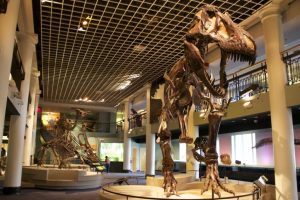
Not far away in New York City and Washington DC we also have the American Museum of Natural History and Smithsonian Natural History Museum respectively. These museum’s are among the best in the world in terms of their fossil collections and I’ve visited them both on several occasions. The images below give just a taste of the exhibits that can be found at these museums.
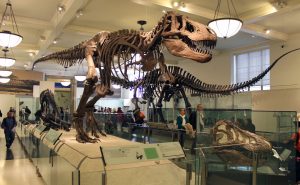
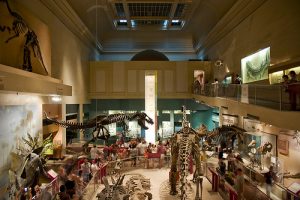
O’k, so the big museums in the big cities have big collections but a lot of people can’t get to New York or Washington. Well other cities have museums as well. Chicago has its Field Museum, Pittsburgh the Carnegie Museum, Atlanta its Fernbank Museum of Natural History and Los Angeles has the La Brea Tar Pits Museum.
In addition to the big museums however there are also all of the parks that have fossil connections. The US National Park Service lists eleven Nation Parks, such as Dinosaur National Park, Florissant Fossil Beds National Park and even Grade Canyon National Park, where visitors can see many of the fossils that have been uncovered there. The link below will take you to a National Park Service site giving information on the eleven national parks with fossil connections.
https://www.npca.org/articles/1336-where-to-touch-a-dinosaur-and-other-incredible-national-park-fossil-sites?s_src=g_grants_ads&gclid=EAIaIQobChMI2teTmeiY2AIVWYezCh0B-w5QEAAYASAAEgKbRPD_BwE
We mustn’t neglect State Parks either. One park I’ve often visited is Poricy Brook State Park in New Jersey. The visitor center there has a nice fossil collection on exhibit along with instructions on where to go in the park to find your own fossils!! Caesar’s Creek State Park in Ohio is much the same, a nice exhibit and directions to the local fossil site. The image below shows a 62cm long specimen of a trilobite on display at the Caesar’s Creek State Park visitor’s center.
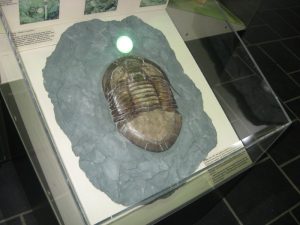
So far all of the museums I’ve mentioned have been in the United States but that doesn’t mean other countries don’t have museums with equally impressive fossil collections, far from it. The Natural History Museum in London has one of the world’s largest collections, including specimens collected by Charles Darwin.
The UK also possesses one of paleontology’s real jewels along England’s south coast; known to fossil hunters as the Jurassic Coast. The Jurassic Coast covers almost 250 million years of Earth’s history and so extensive are the fossils in this region that every little town has its own museum or visitor center displaying fossils discovered there. The image below shows just a bit of the Jurassic coast fossil location.
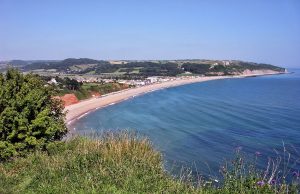
There are many websites dealing with the fossils of the Jurassic Coast, the one below will provide you with a list of some of them.
Other countries have their own museums as well. In Berlin there is the Museum fűr Naturkunde while there is the Jurassic Land Museum in Istanbul. Brussels boasts of the Royal Belgian Institute of Natural Science and Cape Town in South Africa has the Iziko Museum (they have a wonderful collection of fossils of human ancestors).
In recent years China has become one of paleontology’s hotbeds and the Zigong Dinosaur Museum has many of the latest discoveries on exhibit. And let’s not forget Australia where the National Dinosaur Museum displays specimens only found down under.
I hope by now you realize that there are Natural History and fossil museums almost everywhere, you just have to go looking for them. Be careful however, seeing all of those fossils may inspire you to start looking to find some of your own. I can give you some advice on doing that as well but that’ll be another post.
